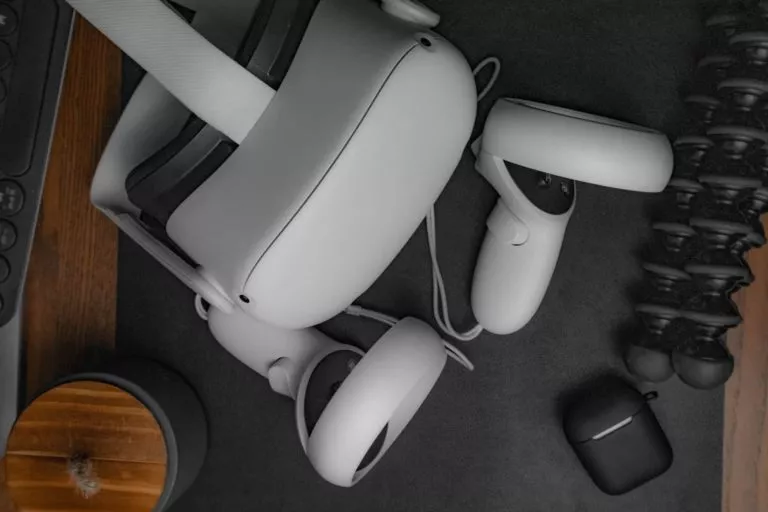
As you may have heard, Meta announced Q2 earnings last week. Among other things, Meta Reality Labs’ (MRL) represented a $2.8 billion expense. There, the message to investors is to stick with Meta while it builds, and cements a central position within, computing’s next era.
Back to the near term, MRL top-line revenue is growing year over year. Specifically, it brought in $452 million in Q2, which mostly consists of Quest 2 sales. That’s up 48 percent from $305 million in Q2 2021 (year over year), but it’s down from $695 million in Q1 2022 (quarter over quarter).
But our big question is how this translates to Quest 2 unit sales for Q2. Equally meaningful, what’s the total installed base of Meta VR devices in market, including Quest 1 and 2? According to Mark Zuckerberg, 10-million is the magic number to ignite VR’s network effect.
Reverse Engineering
Starting with Q2 units sold, what do Meta earnings tell us? This is an exercise we’ve done every quarter for several years, but with a different approach lately given Meta’s disclosures. We no longer have to rely on proxies such as reverse engineering Meta’s “other” revenue category.
Given that Meta now breaks out MRL revenue, this calculation can be more precise. Diving in, Reality Labs made $452 million in Q2 as noted. Based on Meta’s Q4 and 2021 FY disclosures in January, we know that software (VR game and app sales) is about 23 percent of that.
With that, Q2 software revenue comes to $103.96 million*, making hardware $348.04 million. As we’ve estimated, headsets are about 92 percent of that, the rest being first-party accessories like head straps and face shields. That brings us to $320.20 million for Quest 2 sales.
Considering an average unit price of $329** this means that Meta sold approximately 973,243 Quest 2s in Q2. This is on pace with 6.5 million units for full-year 2022, projected by our research arm, ARtillery Intelligence. This projection factors in the standard Q4 holiday surge.
*This figure represents the Oculus Store’s gross revenue, before developer payouts, which are usually 70 percent after taxes.
**During Q2, Quest 2 base model (64GB) was $299 while the 256GB model was $399. This averages out at $349, but we’ve reduced the estimated hardware ARPU to $329 due to weighted sales for the base model (common for new hardware). Third-party reseller markups aren’t included.
Just Shy
So what does the above mean for Meta’s VR installed base? To estimate that figure, we can go back to the results from last time we did the above exercise for Q1. At that time, the installed base was 8.86 million units. So with the above 973,243, it brings the cumulative total to 9.829 million.
The installed base in practical terms could be a bit less, given that the above includes all Quests (including Quest 1) sold to date. That’s a little more than 3 years’ worth of cumulative sales, while the VR hardware replacement cycle is… about 3 years. Older hardware cycles out.
That’s all to say that some of those early sales for Quest 1 may be replaced by newer Quest 2 units. Those replaced units may still be in use or gathering dust in a closet. For the sake of this exercise, we’ll consider them part of the official installed base, given that Meta likely does.
So if this is accurate, Meta is just shy of its 10-million milestone of in-market VR devices. That means it will hit this target sometime in Q3, if it hasn’t already. To be fair, others have estimated that Meta has already passed this 10-million mark, but we stand by our ongoing projections.
Stepping back, why is 10 million important? According to Mark Zuckerberg, that’s the critical mass to jumpstart an ecosystem. A nine-digit sum attracts developers en masse. Content creation surges then attracts more users, which further attracts developers, and the flywheel spins…
In Perspective
Another notable moment in Meta’s Q2 earnings was Zuckerberg’s assertion that he wants MRL revenue to be Meta’s primary business – surpassing its ad business – by 2030. This resolve for AR and VR as the future of Meta puts the $2.8 billion MRL expense in perspective.
Meanwhile, MRL has been painted in interweb punditry as an ill-timed passion project. But considering maturing global growth due to Meta’s size, and the challenges from Apple’s app tracking transparency (ATT), now is precisely the right time to start building its future.
As we examined last week, this is analogous to where Apple sat before it launched what would become its new primary business: the iPhone. The main focus before that point was desktop and laptop computers…a maturing business that was eventually dwarfed by iThings.
Back to Meta, its investments in VR hardware and rumored operating system make it a bonafide platform. And there, it’s less beholden to the uncertainties of piggybacking on others’ platforms – namely iOS and Android. As noted, Meta has learned this lesson the hard way.
Meanwhile, amidst all the handwringing in the tech press, the silver lining for Meta is that MRL’s top line is growing. Net losses are still considerable, but the more important part in a long-game sense (Meta’s playbook) is that it’s using today’s dollars to build tomorrow’s business.

